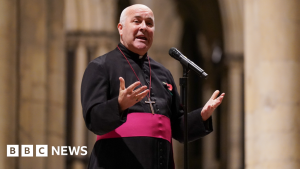
Bitcoin (BTC) slumped below $100,000 after Federal Reserve Chairman Jerome Powell said the central bank is not allowed to own Bitcoin and is not looking for a law change.
Powell’s comments instantly impacted the market, with the price of BTC dropping considerably, dropping below $100,000 to a low of $99,047 before recovering and rising to its current level. BTC is currently down just over 2% and trading around the $101,200 mark.
Speaking about the pullback, ChangeNOW CMO Pauline Shangett noted,
“Powell’s comments sent shockwaves through the crypto market with over $700 million in liquidations in just 24 hours, reflecting the high volatility of the crypto space.”
The market cap also slumped, dropping by 3.50% to $3.52 trillion. Almost all major cryptocurrencies, including Ethereum (ETH), Solana (SOL), Ripple (XRP), Dogecoin (DOGE), Cardano (ADA), Chainlink (LINK), Toncoin (TON), and Polkadot (DOT) are trading in the red.
Bitcoin (BTC) Slumps After FOMC Meeting
Bitcoin (BTC) and the crypto market retreated after the Federal Open Market Committee (FOMC) announced plans to slow down rate cuts in 2025, with the benchmark federal funding rates declining to a range of 4.25% and 4.50%. The Fed cut interest rates by 25 basis points, lowering the federal funds rate. The decision matched expectations from analysts and market watchers. Despite this, the crypto markets registered a substantial decline following the decision. According to analysts, the market reaction was not because of the December rate cut, which was along expected lines, but the outlook for 2025.
Federal Reserve Chair Jerome Powell hinted the bank has revised its 2025 outlook and dropped potential rate cuts from 4 to 2, suggesting a more hawkish outlook for the year, triggering a selloff in the crypto market. The Fed also raised its expectations for PCE inflation from 2.1% to 2.5% at the end of 2025, indicating that inflation could increase in 2025. The Fed’s decision to reduce rate cuts and the potential spike in inflation could also adversely impact the current bull run as investors anticipate an unfavorable market. Following the announcement, BTC slumped below $100,000, dragging the market down.
Federal Reserve Not Allowed To Own Bitcoin
Federal Reserve Chair Jerome Powell rained on the crypto market’s parade after stating the central bank is not allowed to, or looking to hold Bitcoin. As a result, the price of BTC plummeted below $100,000, falling to a low of $99,047 before recovering to its current level. Powell stated,
“We’re not allowed to own Bitcoin. The Federal Reserve Act says what we can own, and we’re not looking for a law change. That’s the kind of thing for Congress to consider, but we are not looking for a law change at the Fed.”
Powell made the comments in response to a question on whether he saw any value in a federal Bitcoin reserve, an idea mooted by President-elect Donald Trump as a way for the US to stay ahead of the competition as other countries embrace digital assets. However, experts have warned of risks associated with volatile assets like BTC. BTC’s value has soared since Donald Trump’s election victory, with the President-elect promising to create a friendly regulatory environment for the crypto ecosystem.
Bitcoin (BTC) Price Analysis
Bitcoin (BTC) is down over 2% in the past 24 hours, as its price dropped following the FOMC meeting. BTC slumped to an intraday low of $99,047 before recovering to reclaim $100,000 and move to its current level. The markets also saw liquidations reach a staggering $700 million following Federal Reserve Chair Jerome Powell reiterating the central bank cannot own Bitcoin. Powell also predicted it could take 1-2 years for inflation to reach the desired 2% target, triggering widespread selloffs.
BTC was quite bullish last week despite starting it in the red. By Tuesday, it plummeted to a low of $94,313 before settling at $96,912 as bearish sentiment took hold. However, the price recovered on Wednesday, rising over 4% to move above $100,000 and settle at $100.900. Despite a positive showing on Thursday, BTC dropped by 0.975 to slip below $100,000 and settle at $99,923. However, buyers returned to the market on Friday as BTC reclaimed the $100,000 level after rising 1.47% and settling at $101,394. BTC registered a marginal decline on Saturday before recovering on Sunday to register a substantial increase of almost 3% and settle at $104,181.
Source: TradingView
BTC started the current week on a positive note, setting an all-time high after climbing to $107,464. However, it declined from this level to settle at $105,746, ultimately registering an increase of 1.50%. BTC surged to a new all-time high on Tuesday, reaching an intraday high of $108,268. However, it could not stay at this level and fell to $106,142, registering a marginal increase. However, market sentiment changed on Wednesday following the FOMC meeting and Fed Chair Jerome Powell’s comments. As a result, BTC plummeted almost 6%, dropping below $100,000 before settling at $100,189.
Sellers yanked BTC to an intraday low of $98,782 during the ongoing session. However, the price has recovered from this level and is currently up by 1.27%, trading around $101,500. BTC faces some resistance around the $108,000 mark. However, analysts are confident it will cross $110,000 by the end of the year.
Ethereum (ETH) Price Analysis
Ethereum (ETH) is attempting to recover after facing a substantial decline this week as sellers tried to drive the price toward $3,500. ETH registered a significant drop last Monday, falling over 7% and settling at $3,715. Sellers drove ETH to an intraday low of $3,521 on Tuesday as bearish sentiment persisted. However, ETH recovered partially from this level to go above the 20-day SMA and settle at $3,630, registering a decline of 2.30%. However, the price recovered on Wednesday, as ETH rallied almost 6% to go above $3,800 and settle at $3,834. Buyers attempted a move past $4,000 on Thursday as ETH reached an intraday high of $3,988. However, buyers lost momentum after reaching this level, and the price dropped to settle at $3,882, an increase of 1.26%.
Source: TradingView
ETH could only register a marginal increase on Friday as it went above $3,900 and settled at $3,907. However, the weekend began on a bearish note as ETH dropped almost 1% and settled at $3,869. The price recovered on Sunday, rising by 2.25% to reclaim $3,900 and settle at $3,956. The current week began with ETH experiencing significant volatility as it rose to an intraday high of $4,106 and fell to an intraday low of $3,882 before buyers took control and pushed ETH to $3,985. However, sentiment changed on Tuesday as buyers lost momentum. As a result, ETH dropped 2.33% and settled at $3,892. Bearish sentiment intensified significantly on Wednesday as ETH plummeted below the 20-day SMA after a drop of nearly 7% and settled at $3,625. The current session sees ETH up almost 2% and trading at $3,693 as buyers attempt to reclaim the $3,800 level.
Solana (SOL) Price Analysis
Solana (SOL) fell below a key support level on Wednesday as selling pressure increased significantly. However, it is attempting a recovery during the current session after dropping to a low of $199. SOL has been trading in a downward trajectory since November 22. Bearish sentiment intensified at the beginning of last week after SOL slipped below the 20-day SMA. With sellers dominating the market, SOL dropped 8.55% on Monday and 1.47% on Tuesday to settle at $213, as sellers attempted to drive it below $200. Despite considerable selling pressure, SOL recovered on Wednesday, rising over 6% and settling at $227. SOL tried to go above the 20-day SMA on Thursday as it rose to an intraday high of $235. However, buyers lost momentum at this level, and the price fell back, dropping to $227 after a marginal decline.
Source: TradingView
Sellers retained control on Friday as SOL dropped almost 1% and settled at $224. Bearish sentiment intensified on Saturday as SOL dropped by 2.22% and settled at $219, but not before falling to an intraday low of $215. Despite the bearish sentiment, SOL recovered on Sunday, rising almost 2% to $224 and ending the weekend positively. However, bearish sentiment returned on Monday as SOL fell by 3.55%, going below the 20-day SMA and settling at $216. SOL recovered on Tuesday as buyers attempted to go above the 20-day SMA. As a result, SOL reached an intraday high of $228 before settling at $223. Despite recovering on Tuesday, SOL fell substantially on Wednesday, registering a drop of 7.48% to slip below the 20-day SMA and key support levels and settle at $206.
Sellers attempted to drag SOL below $200 during the current session as it fell to a low of $199. However, it has recovered from this level and is currently up almost 2%, trading at $210.
Dogwifhat (WIF) Price Analysis
Dogwifhat (WIF) collapsed after briefly surpassing $4 last weekend, with buyers unable to arrest the meme tokens decline. WIF plummeted 18% last Monday as it went below the 20-day SMA and settled at $3.05, but not before hitting an intraday low of $2.58. The price continued to drop on Tuesday as WIF slipped below the 50-day SMA and $3 to settle at $2.84 after a drop of almost 7%. Despite the overwhelming bearish sentiment, WIF recovered on Wednesday, rising over 7% to move past the 50-day SMA and settle at $3.05. Buyers attempted to build momentum as WIF reached an intraday high of $3.19 on Thursday. However, sellers could counter buyers and drive WIF down by 3.34% to $2.94. The price registered a marginal decline on Friday as sellers retained control, preventing a move past the 50-day SMA.
Source: TradingView
Selling pressure intensified on Saturday as WIF dropped just over 4% and settled at $2.84. Despite considerable selling pressure, WIF registered a marginal increase on Sunday to end the weekend positively. However, it was back in the red on Monday, dropping by 3.52% and settling at $2.74. Buyers attempted a recovery on Tuesday but were unsuccessful as WIF dropped 1.58% to $2.70. Bearish sentiment intensified significantly on Wednesday as WIF plummeted almost 15%, going below a key support level and the 200-day SMA to settle at $2.30. The current session sees WIF remain in the red, with the price down over 3% at $2.23.
Toncoin (TON) Price Analysis
Toncoin (TON) has registered a substantial decline this week as it plummeted below key levels as bearish sentiment took hold. Despite registering a drop of over 14% last Monday, TON recovered on Tuesday, rising by 2.41% from an intraday low of $5.50 to settle at $5.94. Bullish sentiment intensified on Wednesday as TON surged almost 7% to move past the 200-day SMA and settle at $6.34. Buyers attempted a move past the 20-day SMA on Thursday as TON reached an intraday high of $6.48. However, buyers lost momentum at this level, and TON registered a marginal drop. Sellers retained control on Friday but could only push TON down marginally, as it settled at $6.29. However, TON registered a notable decline of 1.05% on Saturday as selling pressure intensified and dropped to $6.22.
Source: TradingView
TON registered a strong recovery on Sunday, rising almost 3% to end the weekend positively. However, the current week began with sellers back in control as TON plummeted 5.35% on Monday to go below the 200-day SMA and settle at $6.05. Bearish sentiment persisted on Tuesday as TON slipped below $6 and settled at $5.80. Wednesday saw TON slip below the 50-day SMA, falling over 6% and settling at $5.43. TON fell to a low of $5.16 during the current session. However, it recovered from this level and is currently up almost 1%, trading around $5.47.
Hedera (HBAR) Price Analysis
After plummeting to a low of $0.236 last Monday, Hedera (HBAR) recovered on Tuesday registered an increase of just over 3%, and settled at $0.289 despite facing significant volatility. HBAR continued to push higher on Wednesday, rising almost 3% and settling at $0.298. HBAR dropped on Thursday as buyers failed to maintain momentum, falling just over 2% and settling at $0.292. However, the price recovered on Friday, rising almost 8% and settling at $0.314. HBAR was back in the red on Saturday, dropping just over 6% before registering a marginal increase on Sunday to end the weekend at $0.295.
Source: TradingView
The current week began with HBAR dropping 4.18% to $0.283. It recovered on Tuesday, rising by 0.84% and settling at $0.285 as buyers prevented a drop below the 20-day SMA. However, sellers took control on Wednesday and drove HBAR down by 4.56%. As a result, it went below the 20-day SMA and settled at $0.272. The current session sees HBAR up over 7% as it makes a strong recovery. Buyers will look to push HBAR back above the 20-day SMA and the $0.30 price level.
Theta Network (THETA) Price Analysis
Theta Network (THETA) made a strong recovery after dropping below the 20-day SMA on Tuesday and falling to an intraday low of $2.14, rising almost 9% on Wednesday to go above the 20-day SMA and settle at $2.58. THETA rose to an intraday high of $2.85 on Thursday before settling at $2.67, an increase of 3.35%. Buyers retained control on Friday as the price rose almost 3% and settled at $2.74. However, it was back in the red on Saturday, dropping nearly 5% to go below the 20-day SMA and settle at $2.61.
Source: TradingView
THETA recovered on Sunday, rising by 4.91% to move past the 20-day SMA and settle at $2.73. The price experienced considerable volatility on Monday as buyers and sellers struggled to establish control. Sellers ultimately gained the upper hand as THETA registered a marginal drop and settled at $2.71. It slipped below the 20-day SMA on Tuesday, falling by 0.73% and settling at $2.69. However, selling pressure increased substantially on Wednesday as THETA plummeted almost 14% and settled at $2.32. The current session sees the price down just over 2% at $2.27.
Disclaimer: This article is provided for informational purposes only. It is not offered or intended to be used as legal, tax, investment, financial, or other advice.


























+ There are no comments
Add yours